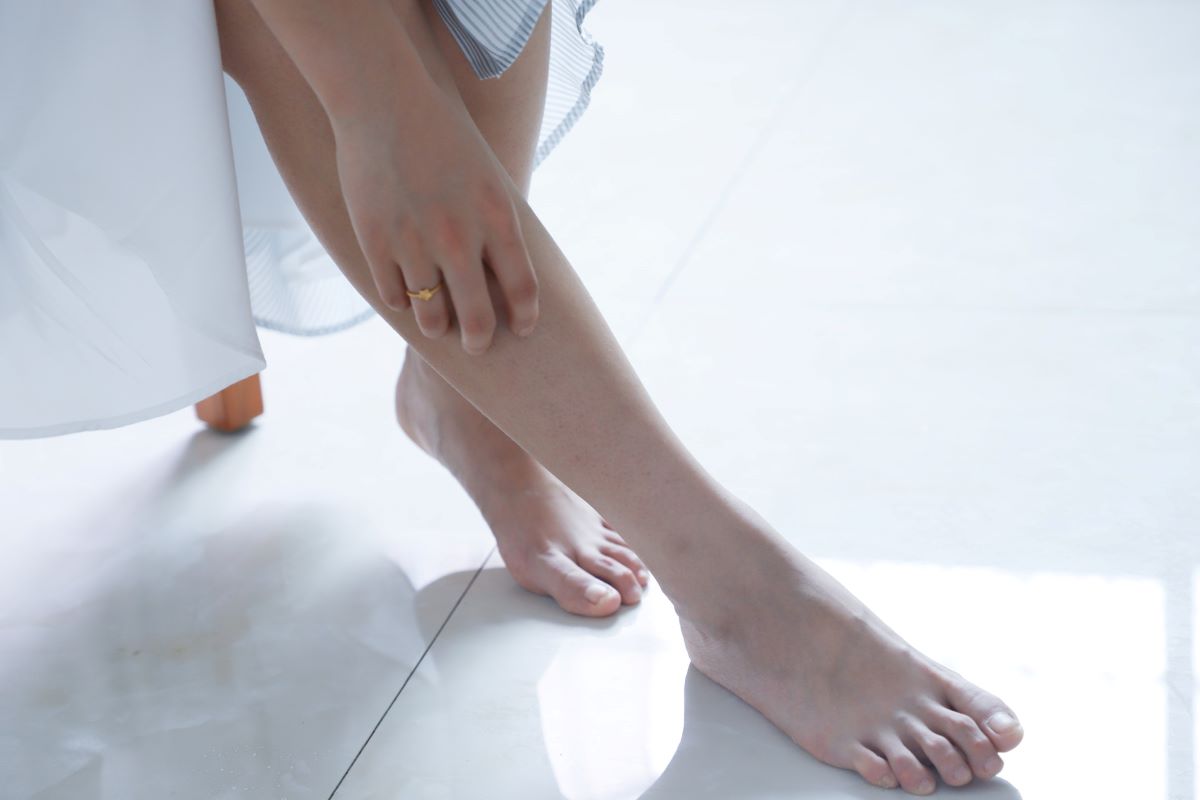Whether we realise it or not, our feet play a vital role in our daily lives. They have a direct influence on our well-being, as they do on everything else in our bodies. As a result, our feet have an impact on our quality of life. The small, basic skills we have at our disposal, such as getting out of bed, moving around, dancing, going to work, shopping, running marathons… are just some of the activities that make us an independent person.
Our feet undergo a lot. They are locked up for hours in unsuitable shoes. Sometimes too tight, too loose, uncomfortable, even torturous… a far from healthy daily routine. In short, we mistreat them without meaning to! And at some point, they inevitably react. We are then confronted with sometimes very annoying problems such as cracked heels, split toes or accumulations of dry skin. If you’re prone to the latter, especially calluses, here’s our advice on how to treat them.
What are calluses?
Calluses are thick layers of hardened skin. They usually develop as a result of repeated rubbing or friction and pressure. These growths are uncomfortable and unsightly. It is important to remember that they are our body’s natural reaction to these aggressions. Calluses on the soles of the feet are caused by inappropriate gait. This can be caused by ill-fitting shoes, high-heeled pumps, sandals with inflexible soles or shoes without socks, etc. Although generally a benign condition, calluses can become infected in certain cases. Spending most of their time in a closed, damp environment, feet are an ideal breeding ground for bacteria.
What are the standard treatments for calluses?
The aim of callus treatment is to reduce the pain and discomfort caused by these lesions. The recommended treatment method involves gentle trimming of the lesion by the healthcare professional, without causing bleeding, using scalpels.Removal of the central nucleus under local anaesthetic may be necessary to reduce pressure on the underlying dermal nerves, thereby relieving pain. Patients are advised to file the treated lesions regularly, every week, using a pumice stone or nail file, after immersing the feet in warm water for twenty minutes. Diabetic patients, particularly those suffering from peripheral sensory neuropathy resulting in reduced skin sensitivity, should be particularly careful. Diabetic callus sufferers are advised to seek the advice of a podiatrist for safe callus debridement, as attempting to do it themselves in the presence of sensory neuropathy could lead to excessive trimming and ultimately skin abrasion.
Is salicylic acid effective against calluses?
Topical keratolytic medicines, such as salicylic acid at a concentration of 12.6% to 40% in the form of a buffer or solution, can be applied to calluses. A randomised controlled trial comparing standard callus trimming with 40% salicylic acid plasters showed that salicylic acid treatment resolved more calluses in proportion, delayed recurrence time, reduced pain and decreased callus size over six months compared to the standard trimming treatment group. Other agents such as 20% to 50% urea, silver nitrate and hydrocolloid dressings can also be used for this indication. These techniques are most effective for a few specific lesions. Topical keratolytic agents can also make it easier to trim lesions by softening calluses.
Ablative laser therapy can also be used to treat calluses instead of trimming them with a scalpel. The carbon dioxide laser has been reported as effective by some authors. The 2,940 nm yttrium-aluminium-garnet-doped erbium laser has been used to treat calluses with minimal thermal tissue damage. However, recurrence of lesions may be observed in some patients, particularly if triggering factors are maintained.
How can calluses be treated at home?
Most of the time, calluses only need treatment if they cause discomfort or pain. Normally, simply removing the source of friction or pressure will gradually make them disappear. However, to relieve them or give them a helping hand to heal, you can opt for these tips and remedies.
Although uncomfortable, calluses can often be effectively treated at home. Here are some home treatment methods:
- Footbaths: Start by soaking your feet in lukewarm water for about 15 to 20 minutes. The warm water will help soften the hard skin of the callus. You can add Epsom salt or a few drops of essential oil to increase the soothing effect.
- Using a pumice stone: After the foot bath, use a pumice stone or foot file to gently rub the callus. This will help remove the layers of hard skin. Do not use sharp objects or razors to remove the skin, as this can cause injury.
- Moisturisers and keratolytics: Apply a moisturiser regularly to keep the skin supple. Creams containing keratolytic ingredients, such as salicylic acid or urea, can be particularly effective in softening calluses.
- Protective dressings: Use special dressings or pads to protect the callus from additional pressure and friction. These can be found in most chemists.
- Pressure reduction: Identify and modify activities or footwear that put excessive pressure on the callus. For example, limit the amount of time you spend standing or wear more comfortable shoes.
What dressing should I use to get rid of a callus?
Compeed’s Callus Bandages Box of 6 can be used on calluses that have already formed. Not only do they stay in place for more than 24 hours, they also offer protection against rubbing. Their cushioning effect absorbs pressure. Their use provides immediate relief from discomfort or pain and helps to speed up the elimination of calluses.
Urgo’s Durillon 5 Bandages are used to treat calluses. These are generally located under the arch of the foot. They take the form of thickened skin caused by repeated rubbing and painful pressure. Bandages soothe the pain as soon as they are applied by removing the pressure areas. This product gently softens and eliminates the callus through an emollient effect thanks to the moisturising action of glycerine, combined with the action of the hydrocolloid mass.
What can be done to prevent calluses?
-
Prevention advice
Preventing calluses starts with paying particular attention to foot health and comfort. It is essential to understand that calluses form in response to repeated pressure and friction. So reducing these factors is crucial. Here are some effective tips for preventing the appearance of corns:
- Foot hygiene: Good foot hygiene is essential. It is advisable to wash your feet regularly with warm water and mild soap, paying particular attention to the spaces between your toes. After washing, it’s important to dry your feet thoroughly, especially between the toes, to prevent dampness, which can contribute to the formation of calluses.
- Moisturising the skin: Apply a moisturising cream every day to keep the skin on your feet supple and prevent it from drying out and forming hard skin. We recommend using creams specifically designed for feet, as they are generally thicker and more nourishing.
- Regular foot check: Inspect your feet regularly for any signs of developing calluses. Early detection can help you take immediate action to prevent them from getting worse.
- Regular pedicure: A professional pedicure can help maintain the health of your feet. However, if you develop calluses, it’s best to consult a chiropodist rather than trying to remove them yourself.
- Avoid inappropriate footwear: Wearing narrow, high-heeled or ill-fitting shoes for long periods can increase the risk of developing calluses. It is advisable to choose shoes that fit the shape of your feet well.
-
Choosing the right shoes
The choice of footwear plays a crucial role in preventing calluses. Poorly-fitting shoes can cause excessive pressure and continuous rubbing on certain parts of the foot, leading to the formation of calluses. Here are some recommendations for choosing appropriate footwear:
- Correct size and shape: Make sure your shoes match the size and shape of your feet. Shoes should not be too tight or too loose. The space at the front of the shoes should allow your toes to move freely.
- Proper support: Choose shoes with good arch support. Good support helps to distribute body weight evenly across your feet, reducing pressure points.
- Breathable materials: Opt for shoes made from breathable materials such as leather or mesh fabrics. These materials allow better air circulation, preventing the build-up of moisture that can soften the skin and make it more susceptible to calluses.
- Quality insoles: Insoles can make a big difference. Choose shoes with comfortable, cushioning insoles. You may also want to consider personalised orthopaedic insoles, especially if you have specific foot problems.
- Alternate shoes: Avoid wearing the same pair of shoes every day. Alternating between different pairs of shoes can help reduce repetitive pressure points on your feet.
By following these prevention tips and choosing appropriate footwear, you can significantly reduce the risk of developing calluses, contributing to the long-term health and comfort of your feet.
Keep your feet hydrated
Apply a nourishing balm or cream regularly, preferably after a bath or shower. These rituals prepare the skin for treatment, making it softer and more absorbent. As well as softening and healing existing calluses, this will prevent them from forming, especially during the summer months when feet are put to the test.
Remove calluses regularly
After your bath, we recommend using a pumice stone to gently remove dead skin and calluses. Pumice is a natural product made from a combination of water and lava, designed to remove rough skin from feet, elbows and hands. It can help reduce the discomfort and pain associated with calluses.
However, it’s important to note that if you notice an abscess or pus coming from your callus, this may be a sign of infection. It is therefore advisable to consult a healthcare professional for appropriate treatment. In this case, you should consult a podiatrist. He or she will prescribe an antibiotic to eliminate the infection.
FAQs
Can calluses be dangerous?
Calluses are not usually dangerous, but they can cause discomfort and pain.
How can I prevent calluses?
You can prevent calluses by choosing well-fitting shoes that don’t rub against the skin and by avoiding wearing high-heeled shoes or ill-fitting shoes for long periods.
Do home remedies work?
Home remedies for calluses, such as soaking the feet or applying Vaseline, can help soften calluses, but they are not always effective in removing them.
Is it safe to cut calluses with a knife?
It is not safe to cut calluses with a knife, as this can cause damage to the skin and increase the risk of infection.
When should I see a doctor?
If your calluses are very painful, if they bleed or if they do not improve with home treatments, it is best to consult a doctor for professional treatment.







